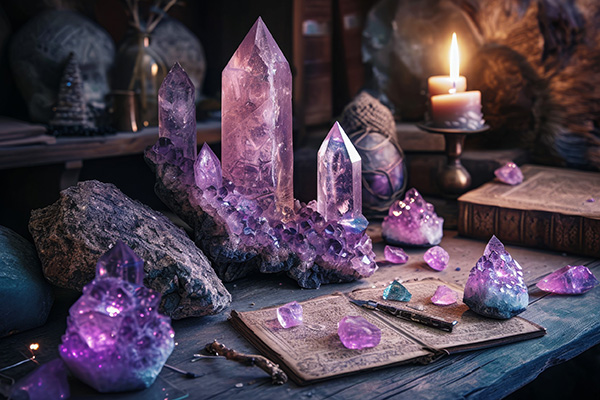energy medicine
The Magic Of Crystals And Gemstones
 Many of my clients light up when you mention the magic of crystals and gemstones, and they usually have a story to tell about a particular stone they own or carry with them for specific intentions, healing, added strength, protection, and so on.
Many of my clients light up when you mention the magic of crystals and gemstones, and they usually have a story to tell about a particular stone they own or carry with them for specific intentions, healing, added strength, protection, and so on.
How do crystals and gems work for you? Well, in many magical ways. When you are attracted to a particular stone, whether it’s color, texture, shape, or other qualities, the attraction you feel to it is the first step in the magical process. This attraction is actually the stone’s way of calling you to it, to make contact.
Sometimes a stone may be given to you by someone, or it may just find its way into your hands in one way or another. The circumstances under which you found it, or perhaps how it found you, is just the beginning of a new and magical relationship.
There are many metaphysicians who believe that crystals and gemstones are our ancestors or ancient beings or life force crystallized from history. Some people believe that certain stones you come in contact with are stones you had in a past life.
They could be pieces of land or rock that surrounded you in past lives here on Earth and are showing up in your life today as a friend or ally. This is pretty cool to think about! Imagine a stone that you have now that you also carried with you before, from another time. Would you still see that stone the same way when you looked at it?
Researchers and historians have hypothesized about pre-Christian cultures and civilizations that considered the standing stones to be the ancient sages or ancient gods. There are unusual theories about sites like Stonehenge and how these large stones got there, as there is still no logical explanation. Some say that Merlin the Magician brought them to Wiltshire, England from a town in Wales called Maenclochog.
The Mystical Healing Power Of Flowers
 If you were to walk into my garden in England, one of the first things you might notice is a beautiful hanging basket full of purple petunias. I put it there for a number of reasons, and not just to admire its beauty. No, it is where it is because of how it makes me feel.
If you were to walk into my garden in England, one of the first things you might notice is a beautiful hanging basket full of purple petunias. I put it there for a number of reasons, and not just to admire its beauty. No, it is where it is because of how it makes me feel.
The energy of flowers is metaphysically powerful and can help you achieve emotional and spiritual well-being. My purple petunias make me feel motivated and full of well-being.
Okay, this may seem like a bold statement, but flowers are truly magical in that they can help increase your productivity and overall happiness, soothe any sensitivities in your life, and motivate you at the same time. And yes, they can do this for you just by looking at them.
So, how do flowers work their magic on us? Mother Nature puts a lot of time and effort into creating beautiful flowers. In fact, a single flower can take weeks or even months to fully develop, making it the part of the plant with the highest energy vibration. When you work with such masterpieces of nature, you are indeed working with the most powerful and purest of energies.
Each flower carries its unique vibrational frequency, which interacts with our own energy fields. This interaction can lead to subtle yet profound changes in our mental, emotional and spiritual state. For example, the vibrant purple hue of petunias resonates with the crown chakra, enhancing our connection to higher consciousness and promoting a sense of peace and clarity. Similarly, the delicate structure and soothing colors of flowers like lavender can harmonize our energy, reducing stress and fostering relaxation.
The Vibrational Alchemy Of Crystal-Infused Water
 I love using crystal water as part of my spiritual practice. Crystal-infused water is an alchemical elixir for harmonizing the body, mind, and spirit.
I love using crystal water as part of my spiritual practice. Crystal-infused water is an alchemical elixir for harmonizing the body, mind, and spirit.
Using the vibrational properties of crystals, this practice involves infusing water with the subtle energies emitted by carefully selected crystals and gemstones. Drinking crystal water is a powerful healing tool and wonderful for maintaining holistic balance and inner harmony.
I like to drink crystal water only once a week. I do not want to interfere with the body’s energetics every day. This is also a great way to get more water into your body and hydrate.
The use of crystals for healing and spiritual purposes dates back thousands of years, originating in the ancient civilizations, such as Egypt, Greece and China. These cultures believed in the energetic properties of crystals and used them for various purposes, including healing, protection, and spiritual connection.
While there is limited historical documentation that specifically mentions crystal-infused water in ancient traditions, it is evident that the ancients held a deep reverence for both crystals and water in their spiritual, healing, and ceremonial practices. Over time, as the awareness of the metaphysical properties of crystals evolved in modern times, the practice of immersing crystals in water for drinking emerged.
Exploring The Benefits Of Reiki Healing
 Reiki healing offers a variety of potential benefits for both your physical and mental well-being. Reiki teaches that when our life force is high, we feel happy, radiant and vital, and when it is low, we feel sick, drained and stressed.
Reiki healing offers a variety of potential benefits for both your physical and mental well-being. Reiki teaches that when our life force is high, we feel happy, radiant and vital, and when it is low, we feel sick, drained and stressed.
Reiki is a form of energy healing in which practitioners use their hands to channel life force energy to the recipient. This universal energy or life force flows through all living things and is called ki in Japanese. The concept is similar to qi (or chi) in Chinese culture and prana in Indian culture.
A qualified Reiki healer is trained to channel healing energy to balance the flow of your life force energy and return you to a state of harmony and vitality.
Reiki has grown in popularity in recent years. Once viewed with skepticism by mainstream medicine, there’s a growing openness to complementary therapies, and Reiki is seen as a gentle and relaxing practice.
In today’s fast-paced world, stress is a major concern. Reiki’s reputation for promoting relaxation and reducing stress makes it attractive to many. Celebrities like Angelina Jolie, Nicole Kidman, Sandra Bullock and Gwyneth Paltrow and any mothers have spoken openly about their use of Reiki, giving it a touch of glamour and social validation.
Interesting Facts You May Not Know About Reiki
 People all over the world are turning to Reiki for its healing power, and it is now even being used in the medical field as a complementary therapy for the treatment of physical, emotional and mental illnesses.
People all over the world are turning to Reiki for its healing power, and it is now even being used in the medical field as a complementary therapy for the treatment of physical, emotional and mental illnesses.
Reiki is a spiritual philosophy and energy healing practice that was developed in Japan in the early 20th century by founder Mikao Usui.
Usui was a Tendai Buddhist whose lifelong quest for spiritual knowledge and healing techniques took him on a journey through many religious and spiritual traditions, including Shintoism, Buddhism, and Christian teachings, as well as the study of martial arts.
The most pivotal moment in Usui’s life occurred on Mount Kurama, a sacred mountain north of Kyoto. After 21 days of fasting and meditation, Usui had a profound spiritual experience of enlightenment that gave him the knowledge and ability to channel healing energy.
This experience led to the development of a healing system he called “Reiki,” which means “universal life energy” or “spiritual energy.” It’s based on the wisdom that “universal energy” can be channeled to support the body’s natural healing processes. Reiki is an extremely powerful energy, yet a remarkably gentle form of healing.
Spiritual Living Begins With Electromagnetic Health
 Your mind-body is electromagnetic. The human brain and body generates and responds to electrical and magnetic fields in ways that science does not yet fully understand.
Your mind-body is electromagnetic. The human brain and body generates and responds to electrical and magnetic fields in ways that science does not yet fully understand.
This electromagnetic activity in our mind-body is particularly prominent in the brain and nervous system, where neurons communicate with each other and with other cells using electrical impulses. It is critical to various mind-body functions, including our thoughts and sensations. The electrical nature of the human body also extends beyond the nervous system. The heart, for example, generates electrical signals.
Why is this important to know? Because our modern lifestyle and the technologically-charged environment in which we live negatively affects our spiritual awareness, intuitive perception, and holistic health.
While many spiritual seekers and psychic students invest a great deal of time and effort in the pursuit of sophisticated spiritual practices, complex energy work modalities, and fancy intuitive development techniques, what they should be paying more attention to instead is the electromagnetic health of their mind-body. Not only is this fundamental to heightened spiritual awareness and healthy living, it is also quite easy and simple to achieve by making some practical changes to your daily lifestyle.
The Spiritual And Therapeutic Energies Of Blue
 In metaphysics, colors are associated with a specific energy signature or vibrational frequency that affects our aura as well as the energy fields in our surroundings. The energy signature of blue carries certain vibrational qualities that have both spiritual and therapeutic significance.
In metaphysics, colors are associated with a specific energy signature or vibrational frequency that affects our aura as well as the energy fields in our surroundings. The energy signature of blue carries certain vibrational qualities that have both spiritual and therapeutic significance.
In spiritual and religious contexts, this color is often associated with the divine and sacred, representing a connection to the heavens and the spiritual realm. The color blue also holds a significant place in various mythologies around the world.
From its celestial associations in Greek mythology, to its divine symbolism in Norse mythology, to its mystical significance in Celtic mythology, blue represents the vastness of the cosmos, the power of divine forces, and the enduring nature of wisdom and knowledge.
Blue is also traditionally associated with spiritual healing and purification and is considered a protective color. It is believed to have a calming and cleansing effect on the mind and spirit. It is also said to ward off negative energies and provide a shield against spiritual harm.
Beyond its spiritual symbolism, blue is considered an important color in color therapy for its various therapeutic effects that promote physical, emotional and spiritual well-being.